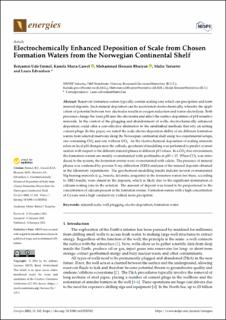Electrochemically Enhanced Deposition of Scale from Chosen Formation Waters from the Norwegian Continental Shelf
Peer reviewed, Journal article
Published version
Permanent lenke
https://hdl.handle.net/11250/2998342Utgivelsesdato
2022Metadata
Vis full innførselSamlinger
- Publikasjoner fra CRIStin - SINTEF AS [5802]
- SINTEF Industri [1567]
Sammendrag
Reservoir formation waters typically contain scaling ions which can precipitate and form mineral deposits. Such mineral deposition can be accelerated electrochemically, whereby the application of potential between two electrodes results in oxygen reduction and water electrolysis. Both processes change the local pH near the electrodes and affect the surface deposition of pH-sensitive minerals. In the context of the plugging and abandonment of wells, electrochemically enhanced deposition could offer a cost-effective alternative to the established methods that rely on setting cement plugs. In this paper, we tested the scale electro-deposition ability of six different formation waters from selected reservoirs along the Norwegian continental shelf using two experimental setups, one containing CO2 and one without CO2. As the electrochemical deposition of scaling minerals relies on local pH changes near the cathode, geochemical modelling was performed to predict oversaturation with respect to the different mineral phases at different pH values. In a CO2-free environment, the formation waters are mainly oversaturated with portlandite at pH > 12. When CO2 was introduced to the system, the formation waters were oversaturated with calcite. The presence of mineral phases was confirmed by powder X-ray diffraction (XRD) analyses of the mineral deposits obtained in the laboratory experiments. The geochemical-modelling results indicate several oversaturated Mg-bearing minerals (e.g., brucite, dolomite, aragonite) in the formation waters but these, according to XRD results, were absent in the deposits, which is likely due to the significant domination of calcium-scaling ions in the solution. The amount of deposit was found to be proportional to the concentration of calcium present in the formation waters. Formation waters with a high concentration of Ca ions and a high conductivity yielded more precipitate.

